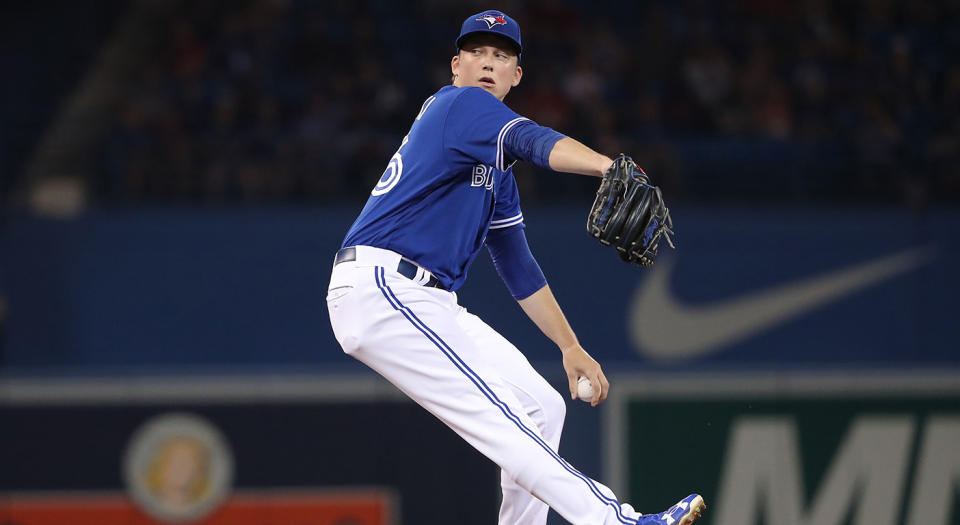Ryan Borucki's future success could rest on one factor
On Tuesday, Ryan Borucki had arguably the least encouraging start across what’s been a string of wildly encouraging starts to begin his big-league career.
The rookie southpaw went four innings and allowed four runs. And although he had some poor luck on balls in play, he owns the ugliness of walking four and striking out one against an anemic Kansas City Royals lineup.
Although the start is far from indicative of what the 24-year-old has to offer, it does give a glimpse at how his profile could be problematic. It seems clear at this point that Borucki is not going to strike out a lot of hitters. He’s running a 5.71 K/9 in the major leagues so far, and in Triple-A this season that number sits at 6.78. His breaking ball is still developing, but it would need to take a huge step forward to be a wipeout pitch.
Now, it’s perfectly OK not to be huge strikeout guy, as long as you compensate elsewhere. There are three primary ways to do that: cutting walks, inducing a batted ball profile that cuts hits and keeping the ball in the park.
Looking at each of these factors, it’s apparent Borucki’s success rests disproportionately on one.

Cutting Walks
Borucki has above-average control and command, which means that keeping walks low should be a constant for him. That said, so far his BB/9 of 3.12 is more solid than outstanding. At Triple-A this season he also ran a 3.27 BB/9, so he hasn’t filled the strike zone like Cliff Lee in his prime.
From here on out it’s probably far to assume Borucki can run a BB/9 somewhere in the 2’s and be a plus in the department, but it also seems unlikely that he’s going to be at the very top of the leaderboards in the category. The lowest BB/9 he’s ever posted was 1.55, but that came in just 46.1 innings at Double-A. FanGraphs’ projection systems have his number for the rest of the season between 2.95 and 3.53.
Cutting Hits
This is the Marco Estrada method, if you will. Inducing tonnes of fly balls and pop ups means opponents are likely to get hits infrequently, even if those hits are more likely to be extra-base knocks.
Borucki doesn’t quite fit the mold though, because he’s more of a groundball pitcher who works off a sinking fastball. Balls are going to get through the infield against him from time-to-time and he’s unlikely to have an exceedingly low BABIP against. So far he’s looking at a .327 mark, and although that should come down, his Statcast contact stats don’t show any special ability to force weak contact.
Here’s how he ranks among the 205 pitchers with at least 150 batted balls against in some key contact-management categories:

None of those numbers exactly jump off the page, so it’s hard to see a compelling reason to believe Borucki will run a low BABIP year-in and year-out.
Keeping the ball in the park
Preventing home runs has been absolutely essential to Borucki’s rapid success at the major-league level. In 52 innings he’s allowed just one round tripper, good for 0.17 HR/9 and 1.8 percent HR/Flyball rates.
Those numbers are both bonkers and impossible to sustain going forward. His FIP of 3.18 ranks 18th among MLB starters with at least 50 innings pitched, while his xFIP (a version of FIP assuming pitchers allow home runs on an average percentage of fly balls) of 4.74 ranks 132nd.
That said, it’s worth asking if Borucki does have a knack for preventing the long ball, because it will be essential to his success.
Interestingly, he has had a run like this before in the minor leagues. Back in 2016, Borucki allowed one home run in 115.2 innings – an astounding 0.08 HR/9 home run rate. That was with the Lansing Lugnuts, though.
To be fair to the 24-year-old, he does have some of the characteristics of a home run-suppressing pitcher. He’s posted high popup rates in the minors and, as a changeup-heavy lefty, he could follow in the footsteps of Jason Vargas or his idol Mark Buehrle in making a living off weak fly balls. It’s possible that of the three ways to compensate for a low strikeout rate, this is his ticket to big-league success.
At the same time, preventing the long ball is something that’s very difficult to repeat season after season to the point that some would consider it more luck than skill. A handful of pitchers, like Clayton Kershaw and Matt Cain in his prime, have ridden low HR/FB rates to peripheral-busting ERAs, but it’s far from the norm.
If Borucki can’t, he’ll probably look a lot more like the bottom-of-the-rotation depth starter he was expected to be than the emerging stud he’s looked like so far.
More Blue Jays coverage from Yahoo Canada Sports:


